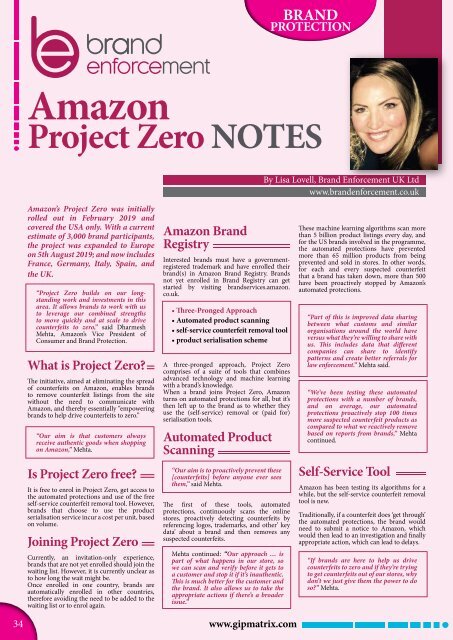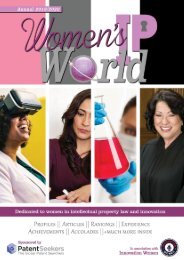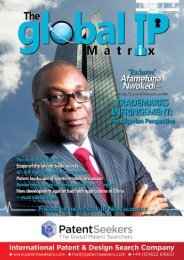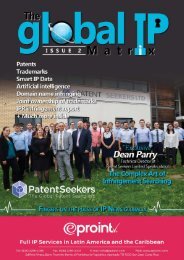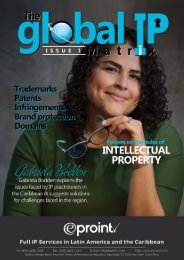Global IP Matrix - Issue 5
It has been a fantastic year for The Global IP Matrix magazine, thanks to all the efforts made by our contributors and to you, the reader for your continued support. We take great pleasure in putting together each issue of this publication, and we sincerely hope you enjoy this final issue of 2019. We have again, collaborated with some of the world's most influential IP law firms and businesses to bring you another eclectic mix of content, direct from the professionals working at ground level. We are already excited for the coming year and cannot wait to continue growing and evolving in our partnerships to bring you some exciting new features for 2020. Ms. Elvin Hassan Editor & Head of international liaisons
It has been a fantastic year for The Global IP Matrix magazine, thanks to all the efforts made by our contributors and to you, the reader for your continued support. We take great pleasure in putting together each issue of this publication, and we sincerely hope you enjoy this final issue of 2019. We have again, collaborated with some of the world's most influential IP law firms and businesses to bring you another eclectic mix of content, direct from the professionals working at ground level. We are already excited for the coming year and cannot wait to continue growing and evolving in our partnerships to bring you some exciting new features for 2020.
Ms. Elvin Hassan
Editor & Head of international liaisons
You also want an ePaper? Increase the reach of your titles
YUMPU automatically turns print PDFs into web optimized ePapers that Google loves.
TRADEMARKS<br />
BRAND<br />
PROTECTION<br />
Amazon<br />
Project Zero NOTES<br />
By Lisa Lovell, Brand Enforcement UK Ltd<br />
www.brandenforcement.co.uk<br />
Amazon’s Project Zero was initially<br />
rolled out in February 2019 and<br />
covered the USA only. With a current<br />
estimate of 3,000 brand participants,<br />
the project was expanded to Europe<br />
on 5th August 2019; and now includes<br />
France, Germany, Italy, Spain, and<br />
the UK.<br />
“Project Zero builds on our longstanding<br />
work and investments in this<br />
area. It allows brands to work with us<br />
to leverage our combined strengths<br />
to move quickly and at scale to drive<br />
counterfeits to zero,” said Dharmesh<br />
Mehta, Amazon’s Vice President of<br />
Consumer and Brand Protection.<br />
What is Project Zero?<br />
The initiative, aimed at eliminating the spread<br />
of counterfeits on Amazon, enables brands<br />
to remove counterfeit listings from the site<br />
without the need to communicate with<br />
Amazon, and thereby essentially “empowering<br />
brands to help drive counterfeits to zero.”<br />
“Our aim is that customers always<br />
receive authentic goods when shopping<br />
on Amazon,” Mehta.<br />
Is Project Zero free?<br />
It is free to enrol in Project Zero, get access to<br />
the automated protections and use of the free<br />
self-service counterfeit removal tool. However,<br />
brands that choose to use the product<br />
serialisation service incur a cost per unit, based<br />
on volume.<br />
Joining Project Zero<br />
Currently, an invitation-only experience,<br />
brands that are not yet enrolled should join the<br />
waiting list. However, it is currently unclear as<br />
to how long the wait might be.<br />
Once enrolled in one country, brands are<br />
automatically enrolled in other countries,<br />
therefore avoiding the need to be added to the<br />
waiting list or to enrol again.<br />
Amazon Brand<br />
Registry<br />
Interested brands must have a governmentregistered<br />
trademark and have enrolled their<br />
brand(s) in Amazon Brand Registry. Brands<br />
not yet enrolled in Brand Registry can get<br />
started by visiting brandservices.amazon.<br />
co.uk.<br />
• Three-Pronged Approach<br />
• Automated product scanning<br />
• self-service counterfeit removal tool<br />
• product serialisation scheme<br />
A three-pronged approach, Project Zero<br />
comprises of a suite of tools that combines<br />
advanced technology and machine learning<br />
with a brand’s knowledge.<br />
When a brand joins Project Zero, Amazon<br />
turns on automated protections for all, but it’s<br />
then left up to the brand as to whether they<br />
use the (self-service) removal or (paid for)<br />
serialisation tools.<br />
Automated Product<br />
Scanning<br />
“Our aim is to proactively prevent these<br />
[counterfeits] before anyone ever sees<br />
them,” said Mehta.<br />
The first of these tools, automated<br />
protections, continuously scans the online<br />
stores, proactively detecting counterfeits by<br />
referencing logos, trademarks, and other’ key<br />
data’ about a brand and then removes any<br />
suspected counterfeits.<br />
Mehta continued: “Our approach … is<br />
part of what happens in our store, so<br />
we can scan and verify before it gets to<br />
a customer and stop it if it’s inauthentic.<br />
This is much better for the customer and<br />
the brand. It also allows us to take the<br />
appropriate actions if there’s a broader<br />
issue.”<br />
These machine learning algorithms scan more<br />
than 5 billion product listings every day, and<br />
for the US brands involved in the programme,<br />
the automated protections have prevented<br />
more than 65 million products from being<br />
prevented and sold in stores. In other words,<br />
for each and every suspected counterfeit<br />
that a brand has taken down, more than 500<br />
have been proactively stopped by Amazon’s<br />
automated protections.<br />
“Part of this is improved data sharing<br />
between what customs and similar<br />
organisations around the world have<br />
versus what they’re willing to share with<br />
us. This includes data that different<br />
companies can share to identify<br />
patterns and create better referrals for<br />
law enforcement.” Mehta said.<br />
“We’ve been testing these automated<br />
protections with a number of brands,<br />
and on average, our automated<br />
protections proactively stop 100 times<br />
more suspected counterfeit products as<br />
compared to what we reactively remove<br />
based on reports from brands,” Mehta<br />
continued.<br />
Self-Service Tool<br />
Amazon has been testing its algorithms for a<br />
while, but the self-service counterfeit removal<br />
tool is new.<br />
Traditionally, if a counterfeit does ‘get through’<br />
the automated protections, the brand would<br />
need to submit a notice to Amazon, which<br />
would then lead to an investigation and finally<br />
appropriate action, which can lead to delays.<br />
“If brands are here to help us drive<br />
counterfeits to zero and if they’re trying<br />
to get counterfeits out of our stores, why<br />
don’t we just give them the power to do<br />
so?” Mehta.<br />
34 www.gipmatrix.com


